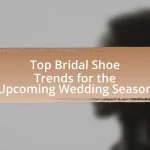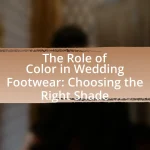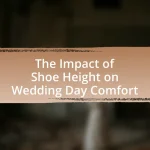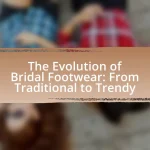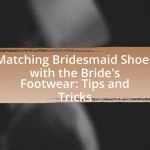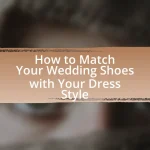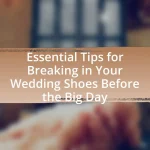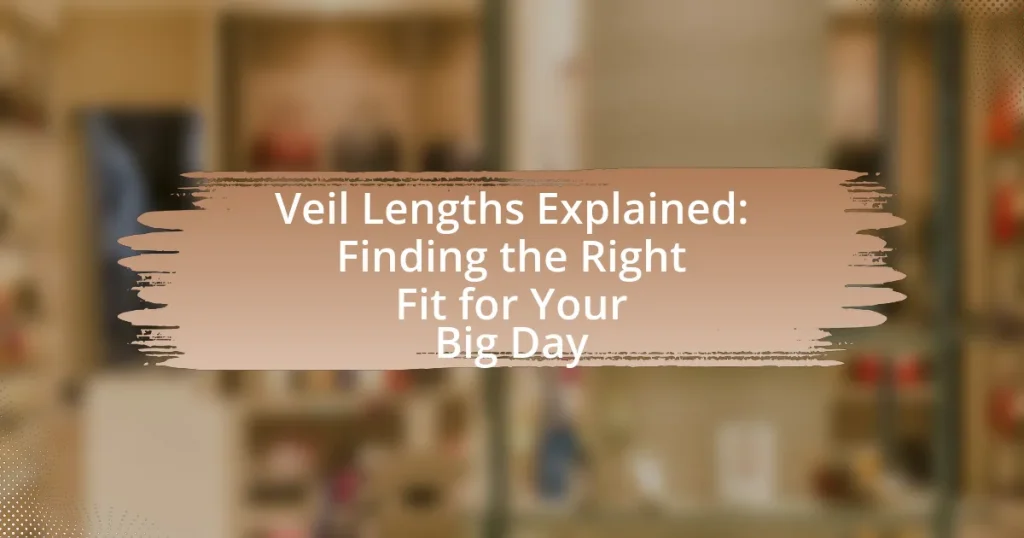The article “Veil Lengths Explained: Finding the Right Fit for Your Big Day” provides a comprehensive overview of the various veil lengths available for weddings, including birdcage, shoulder, elbow, fingertip, chapel, and cathedral lengths. It discusses how each veil length impacts the overall bridal look, complements different wedding dress styles, and aligns with the wedding theme and venue. Additionally, the article highlights the importance of selecting the right veil length based on factors such as body type, comfort, and maintenance, while also offering tips for trying on veils to ensure a perfect match for the bride’s hairstyle and gown.
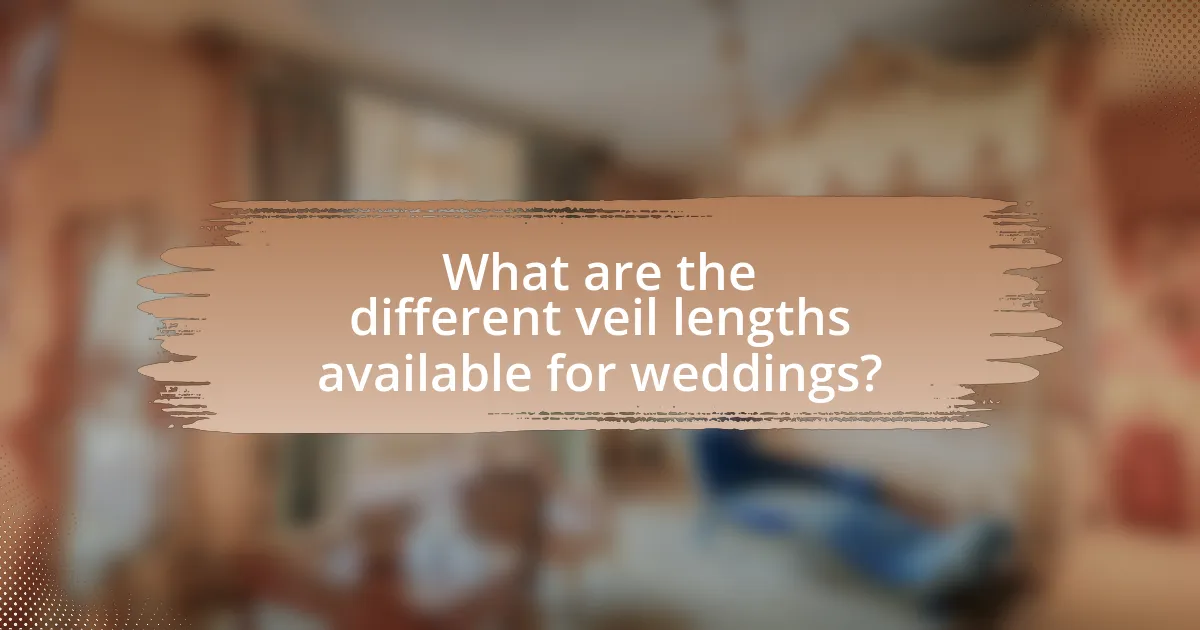
What are the different veil lengths available for weddings?
The different veil lengths available for weddings include birdcage (typically 9-12 inches), shoulder length (around 20-24 inches), elbow length (approximately 25-30 inches), fingertip length (about 30-36 inches), chapel length (around 90-108 inches), and cathedral length (ranging from 120 inches to over 200 inches). Each length serves a distinct aesthetic purpose and complements various bridal styles, allowing brides to choose based on their gown and personal preference.
How do veil lengths impact the overall bridal look?
Veil lengths significantly impact the overall bridal look by influencing the silhouette, style, and formality of the wedding attire. Longer veils, such as cathedral veils, create a dramatic effect and enhance the elegance of a gown, often suited for formal weddings. In contrast, shorter veils, like birdcage or fingertip veils, offer a more casual and contemporary appearance, complementing simpler dresses. The choice of veil length can also affect the bride’s movement and comfort, as longer veils may require more careful handling. Ultimately, the selected veil length should harmonize with the dress style and the overall wedding theme, ensuring a cohesive bridal look.
What are the most popular veil lengths and their characteristics?
The most popular veil lengths are fingertip, chapel, and cathedral, each with distinct characteristics. Fingertip veils typically measure around 30 to 36 inches and offer a modern look that complements various dress styles while allowing for ease of movement. Chapel veils range from 90 to 108 inches, providing a romantic touch that extends to the floor, often used for formal ceremonies. Cathedral veils are the longest, measuring 120 inches or more, creating a dramatic effect as they trail behind the bride, ideal for grand venues. These lengths are favored for their versatility and ability to enhance the overall bridal aesthetic.
How does each veil length complement different wedding dress styles?
Veil lengths complement different wedding dress styles by enhancing the overall aesthetic and silhouette of the bride. For example, a fingertip veil pairs well with a fitted gown, as it accentuates the body’s lines without overwhelming the dress. A chapel-length veil complements ball gown styles, adding drama and elegance while maintaining balance. A cathedral veil, being the longest, is ideal for formal, elaborate dresses, creating a striking visual impact that enhances the grandeur of the gown. Each veil length serves to either highlight or harmonize with the dress’s design elements, ensuring a cohesive bridal look.
Why is it important to choose the right veil length?
Choosing the right veil length is crucial because it affects the overall aesthetic and harmony of the bridal look. The veil length can complement the wedding dress style, enhance the bride’s features, and influence the visual proportions of the ensemble. For instance, a long cathedral veil may create a dramatic effect suitable for formal weddings, while a shorter veil can provide a more casual and playful appearance. Additionally, the right veil length ensures comfort and practicality, allowing the bride to move freely without obstruction.
What factors should be considered when selecting a veil length?
When selecting a veil length, factors such as the wedding dress style, venue, and personal preference should be considered. The wedding dress style influences how the veil complements the overall look; for example, a long train may pair well with a longer veil, while a simpler dress might suit a shorter veil. The venue also plays a role; outdoor settings may benefit from shorter veils to avoid tangling, while formal indoor venues can accommodate longer styles. Personal preference is crucial, as individual taste dictates comfort and aesthetic appeal, ensuring the bride feels confident on her big day.
How does the venue influence the choice of veil length?
The venue significantly influences the choice of veil length by dictating the overall style and formality of the wedding. For instance, a grand cathedral or ballroom typically calls for longer veils, such as cathedral or chapel lengths, which complement the opulence of the setting. In contrast, a beach or garden venue often suits shorter veils, like birdcage or fingertip lengths, which align with a more casual and relaxed atmosphere. This correlation between venue and veil length is supported by wedding planning trends that emphasize matching attire to the environment, ensuring a cohesive aesthetic throughout the event.
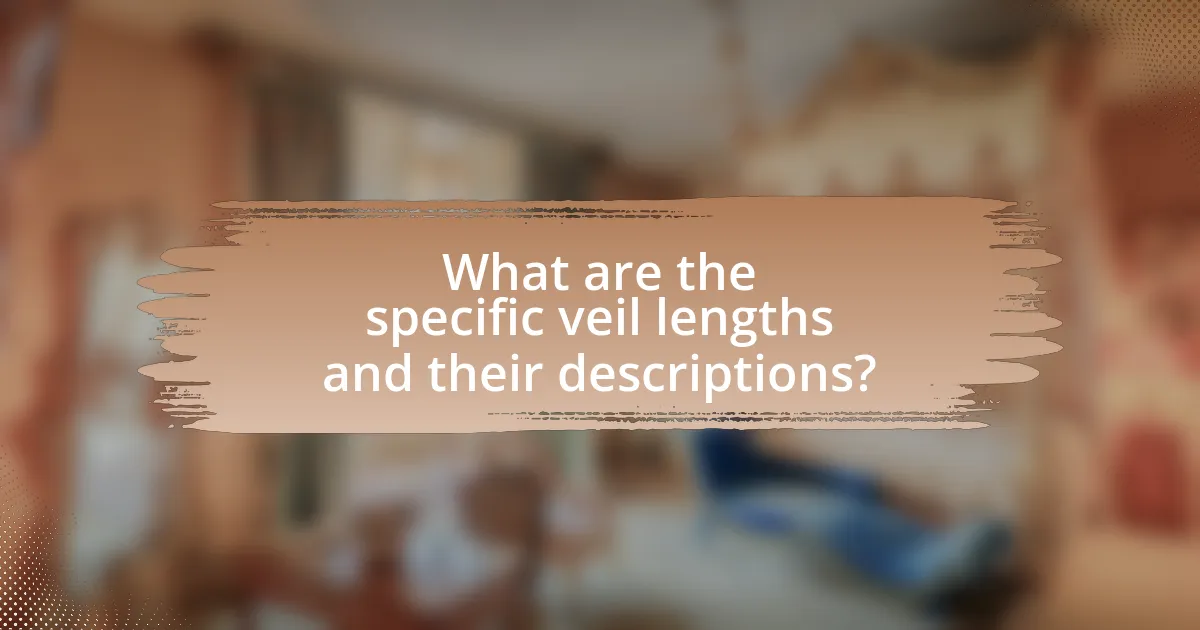
What are the specific veil lengths and their descriptions?
The specific veil lengths and their descriptions include the following:
- Birdcage Veil: This short veil typically measures 9 to 12 inches and covers the face, creating a vintage look.
- Elbow Veil: Ranging from 25 to 30 inches, this veil falls to the elbows and is ideal for a more casual or semi-formal appearance.
- Fingertip Veil: Measuring approximately 30 to 36 inches, this veil reaches the fingertips and is versatile for various wedding styles.
- Chapel Veil: This longer veil extends from 90 to 108 inches, trailing behind the bride and adding a dramatic effect.
- Cathedral Veil: The longest option, measuring 120 inches or more, this veil creates a grand statement, often used in formal weddings.
These lengths provide brides with options that suit different styles and themes for their wedding day.
What is the significance of a fingertip veil?
A fingertip veil is significant as it symbolizes elegance and tradition in bridal attire. This veil length, which typically falls to the bride’s fingertips, enhances the overall silhouette and adds a touch of sophistication to the wedding look. Historically, fingertip veils have been associated with modesty and purity, often worn to signify the transition from singlehood to marriage. Additionally, the fingertip length allows for versatility in styling, making it suitable for both formal and semi-formal weddings, thereby reinforcing its enduring popularity among brides.
How does a fingertip veil enhance the bridal silhouette?
A fingertip veil enhances the bridal silhouette by creating a visually elongating effect that complements the gown’s lines. This veil length typically falls at the fingertips, allowing it to frame the bride’s figure without overwhelming it, thus accentuating the waist and creating a balanced appearance. The delicate nature of a fingertip veil also adds an element of elegance, drawing attention to the bride’s face and hairstyle while maintaining a sophisticated look.
What styles of dresses pair well with a fingertip veil?
A fingertip veil pairs well with A-line, ball gown, and sheath dresses. A-line dresses complement the veil’s length by creating a balanced silhouette, while ball gowns enhance the dramatic effect of the veil. Sheath dresses provide a sleek look that allows the veil to flow elegantly. These styles are commonly chosen for weddings, as they harmonize with the veil’s design and length, ensuring a cohesive bridal appearance.
What are the features of a cathedral veil?
A cathedral veil is characterized by its dramatic length, typically extending beyond the train of the wedding gown, often measuring between 108 to 120 inches. This veil features a flowing design that adds elegance and grandeur to the bridal look, making it suitable for formal ceremonies. Cathedral veils can be made from various materials, including tulle, lace, or silk, and often incorporate intricate embellishments such as lace trim or beading, enhancing their visual appeal. The combination of length and detail creates a striking effect, making cathedral veils a popular choice for brides seeking a traditional and sophisticated appearance on their wedding day.
How does a cathedral veil create a dramatic effect?
A cathedral veil creates a dramatic effect by its exceptional length, typically extending beyond the train of the wedding gown. This extended length enhances the visual impact during the ceremony, as it flows gracefully behind the bride, creating a sense of grandeur and elegance. The veil’s sheer fabric also adds an ethereal quality, allowing light to filter through, which accentuates the bride’s features and attire. Historically, cathedral veils have been associated with formal and traditional weddings, reinforcing their dramatic presence as a symbol of sophistication and bridal beauty.
What occasions are best suited for wearing a cathedral veil?
Cathedral veils are best suited for formal occasions, particularly weddings. Their length, typically extending beyond the train of the gown, adds a dramatic and elegant touch that complements the grandeur of traditional church ceremonies and formal receptions. Historically, cathedral veils have been associated with bridal attire, symbolizing purity and tradition, making them a popular choice for brides seeking a classic and sophisticated look on their wedding day.
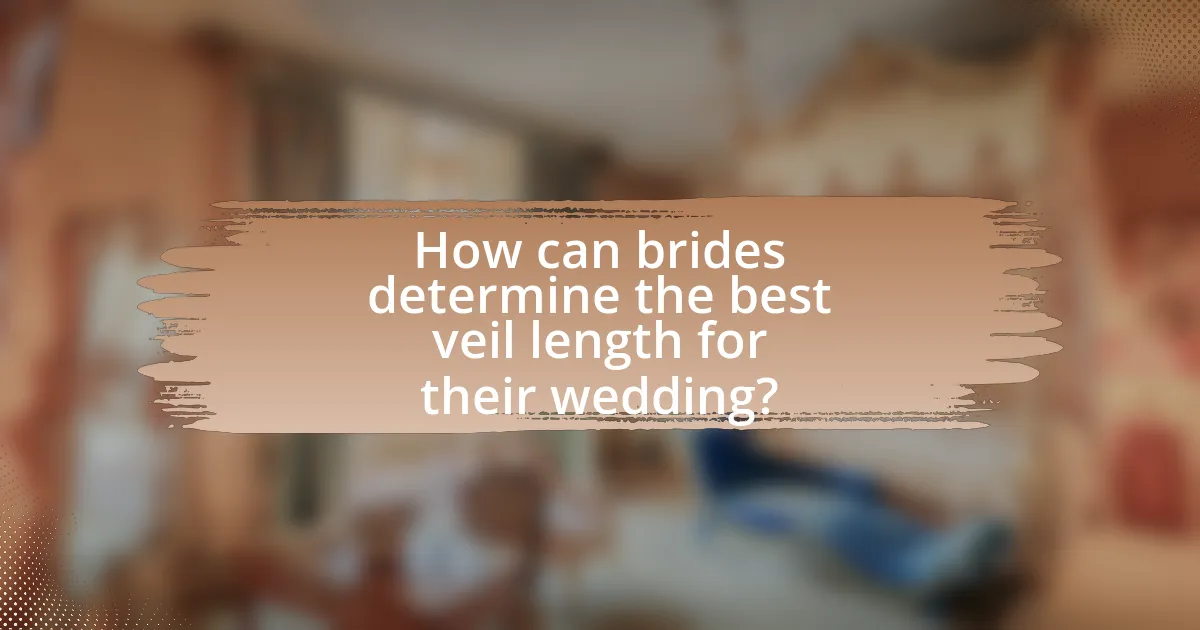
How can brides determine the best veil length for their wedding?
Brides can determine the best veil length for their wedding by considering their dress style, body type, and the overall wedding theme. The veil length should complement the gown; for instance, a long train may pair well with a cathedral veil, while a simpler dress might suit a shorter veil. Additionally, brides should assess their height and proportions, as certain lengths can enhance or detract from their silhouette. For example, a fingertip veil can elongate the appearance of shorter brides, while longer veils can create a dramatic effect for taller brides. Ultimately, the chosen veil length should align with the bride’s personal style and the formality of the wedding, ensuring a cohesive look.
What tips can help brides choose the perfect veil length?
Brides can choose the perfect veil length by considering their dress style, body type, and wedding theme. The veil should complement the gown; for instance, a long train may pair well with a cathedral veil, while a simpler dress might suit a shorter veil. Additionally, brides with petite frames may opt for shorter veils to avoid overwhelming their stature, while taller brides can carry longer veils effectively. The wedding theme also plays a crucial role; a formal event may call for a more elaborate veil, whereas a casual setting might be better suited for a simpler design. These considerations ensure that the veil enhances the overall bridal look.
How should brides consider their height when selecting a veil length?
Brides should consider their height as a crucial factor when selecting veil length, as it directly influences the overall aesthetic and balance of their bridal look. Taller brides may opt for longer veils, such as cathedral or chapel lengths, which can complement their stature and create a dramatic effect. In contrast, shorter brides often benefit from shorter veils, like birdcage or fingertip lengths, which can enhance their proportions and avoid overwhelming their frame. This guideline is supported by the principle of visual balance in fashion, where the length of the veil should harmonize with the bride’s height to achieve a cohesive appearance.
What role does the wedding theme play in veil length selection?
The wedding theme significantly influences veil length selection by dictating the overall aesthetic and formality of the event. For instance, a formal wedding theme may call for longer veils, such as cathedral or chapel lengths, which enhance the elegance of traditional attire. Conversely, a casual or bohemian theme often favors shorter veils, like birdcage or fingertip lengths, aligning with a more relaxed atmosphere. This correlation between theme and veil length is supported by bridal fashion trends, where designers often create collections that reflect specific themes, ensuring that the veil complements the dress and overall wedding style.
What common mistakes should brides avoid when choosing veil lengths?
Brides should avoid choosing veil lengths that do not complement their body type and dress style. Selecting a veil that is too long or too short can disrupt the overall silhouette and aesthetic of the bridal look. For instance, a floor-length gown typically pairs well with a cathedral veil, while a tea-length dress may look best with a shorter veil. Additionally, brides often overlook the venue’s setting; a long veil may be impractical for outdoor weddings with wind. Understanding these factors ensures that the chosen veil enhances the bridal appearance rather than detracts from it.
How can brides ensure their veil complements their hairstyle?
Brides can ensure their veil complements their hairstyle by selecting a veil that matches the style, length, and volume of their hair. For instance, if a bride has an updo, a shorter veil may enhance the hairstyle without overwhelming it, while a longer veil can create a dramatic effect. Additionally, brides should consider the texture and embellishments of both the veil and the hairstyle; a simple veil pairs well with intricate hairstyles, while a detailed veil complements simpler hairdos. This approach is supported by bridal stylists who emphasize the importance of harmony between the veil and hairstyle to achieve a cohesive bridal look.
What should brides keep in mind regarding veil maintenance and comfort?
Brides should prioritize proper storage and cleaning of their veils to ensure maintenance and comfort. Storing veils in a cool, dry place, preferably in a breathable garment bag, prevents damage and maintains their shape. Regularly checking for any stains or dirt is essential, as immediate cleaning can prevent permanent marks. Additionally, brides should consider the weight and length of the veil, as heavier or longer veils may cause discomfort during prolonged wear. Choosing a veil made from lightweight materials can enhance comfort, especially for outdoor weddings.
What are the best practices for trying on veils before the wedding?
The best practices for trying on veils before the wedding include selecting a variety of styles and lengths to assess how they complement the wedding dress. Brides should schedule appointments at bridal shops that allow for ample time to try on multiple veils, ensuring they can see how each option interacts with their hairstyle and overall look. Additionally, bringing along accessories such as hairpieces can help visualize the complete ensemble. It is also advisable to consider the venue and wedding theme, as these factors influence veil choice. Trying on veils in natural lighting can provide a better perspective on how the fabric and details appear.
